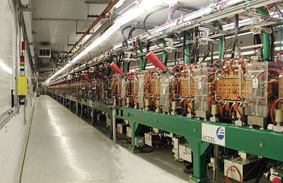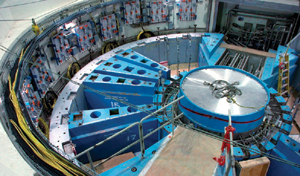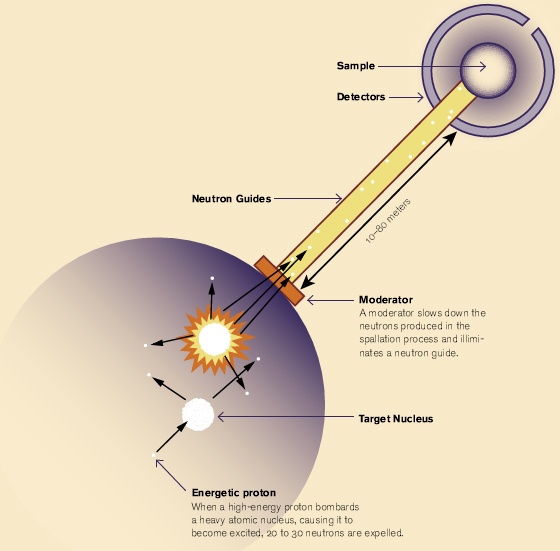SNS: Neutrons for "molecular movies"
Successful launch at Oak Ridge: six labs collaborate on the largest unclassified science construction project in the United States.
By Bill Cabage
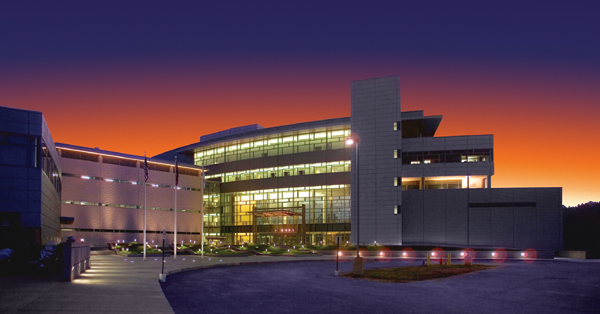 |
| Image source: ORNL, Sandbox Studio |
The scene is reminiscent of Mission Control for a 1960s space shot–minus the skinny ties, pocket-protectors, and cigarette smoke. But the intensity in the control room at 1:30 in the afternoon on Friday, April 28, 2006 approximates that of a lunar landing.
The eyes of operators, project managers, and a few special guests track the numbers and graphs on control monitors. DOE's Spallation Neutron Source at Oak Ridge National Laboratory is about to attempt to send a beam of trillions of protons to a target. If the effort succeeds, it will mark the completion of a seven-year, $1.4 billion effort, the United States' largest unclassified science construction project.
Among the furrowed brows in the control room, Jack Carpenter's smile stands out. Wearing a navy blazer, with an expensive-looking camera around his neck, Carpenter is a special guest. He gets credit for proposing, back in the 1970s, the idea of a spallation neutron source that would combine the advantages of a pulsed neutron source with time-of-flight neutron scattering instruments– the key concepts at the core of the SNS. He's often come to Oak Ridge from Argonne National Laboratory to help with the project. Now launch day is here.
Why neutrons? Why the SNS?
When a fast particle, such as a high-energy proton, bombards a heavy atomic nucleus, some neutrons are "spalled," or knocked out from the nucleus, in a nuclear reaction called spallation. Other neutrons are "boiled off" as the bombarded nucleus heats up. It's something like throwing a baseball at a bucket of balls, resulting in a few being immediately ejected and many more bouncing around and falling out. For every proton striking the target nucleus, 20 to 30 neutrons are expelled. Wave guides channel beams of spalled neutrons to instruments that probe material structures and properties.
Neutrons are abundant in the universe, making up more than half of all visible matter. But for research on physical and biological materials, neutrons of the right brightness are in short supply. Just as we prefer a bright light to a dim one to read the fine print in a book, researchers need a bright source of neutrons that will give detailed snapshots of material structure and make "movies" of molecules in motion. The SNS will provide these bright neutrons. Like a flashing strobe light providing high-speed illumination of an object, the SNS will produce pulses of neutrons every 17 milliseconds, with more than 10 times more neutrons than are produced at the most powerful pulsed neutron sources currently available. Like water spraying from a rock splashed by a garden hose, neutrons from a beam "scatter" from a target material in a way that reveals its structure and properties.
Why pulsed neutrons? To analyze the results of neutron scattering, scientists need to know the initial energy of the neutrons spraying off the material they are studying. When all the neutrons leave the starting gate at the same time–in a pulse–the time it takes each neutron to reach the target material–its time of flight–is known, revealing its velocity and hence its energy. With this key piece of information on neutron energy, scientists can interpret what neutron scattering is telling them about a material under study. In contrast, neutrons from a reactor leave the source continuously, rather than in a single pulse, making time-of-flight energy determination impossible.
Although there are fewer accelerator-based neutron sources than reactor-based sources, accelerator-based pulsed spallation sources represent the state of the art. Japan's J-PARC will have a spallation source coming on line in 20082009 with one-megawatt power. The UK's Rutherford Laboratory is upgrading the ISIS facility to give it a power boost and a second target station.
The applications of neutron scattering seem almost limitless. Neutron scattering probes the behavior of internal magnetic fields in advanced high-temperature superconducting materials such as yttrium-barium-copper-oxide, allowing scientists to view these fields directly. Neutron scattering also reveals the structure and molecularlevel dynamics of semiconductors used in the race to develop new materials for the electronics industry. Small-angle neutron scattering–aiming the garden hose just so–can reveal clusters as small as 50 atoms that form, for example, in the steel of reactor pressure vessels after years of exposure to radiation from the reactor core. The neutrons can show whether heat treatment removes defects from the irradiated steel, making it less brittle and less susceptible to failure.
Something new?
With a beam power of 1.4 megawatts, the SNS will become the world's leading facility for neutron scattering research–eight times more powerful than next-brawniest ISIS. A power upgrade and second target station–with a different assortment of specialized instruments to add to its 24 beamlines–are already on the DOE Office of Science drawing board.
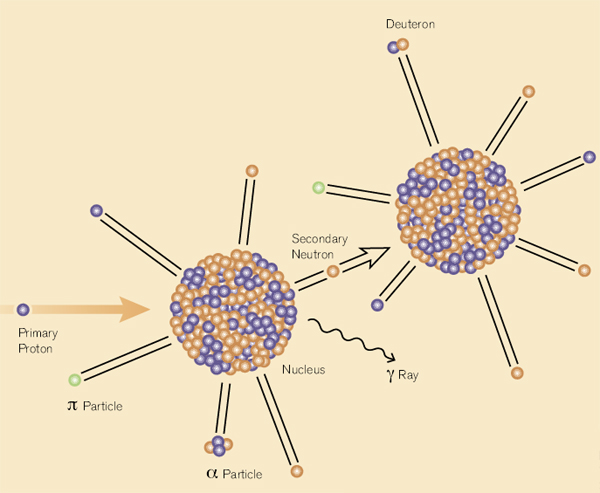 |
|
|
| Source: ORNL |
The development of the neutron as an analytical tool came largely as a spin-off from World War II weapons research. The initial discoveries were made at Oak Ridge, originally a pilot plant for the reactors that would produce plutonium for the Manhattan Project. Scientists working at Oak Ridge's Graphite Reactor realized that light atoms as well as heavy ones could be probed by exposure to neutrons. Two researchers, Ernest Wollan and Clifford Shull, approached ORNL's then-scientific director, the esteemed Eugene Wigner, with their work. "Maybe there is something new here," Wigner remarked.
Now neutrons are a favored tool for investigating the properties of materials. Because a neutron is electrically neutral–hence its name–it can penetrate deep into a material. Unlike the case of X-rays, the probability of neutron scattering does not depend on the number of protons in a material's nucleus, so it can probe light elements as well as heavy ones. Neutrons easily reveal hydrogen atoms, a capability especially useful in studying biological materials.
Neutrons are magnetic; the size and direction of a neutron's magnetic field is called its magnetic moment. Beams of neutrons can be polarized according to their magnetic moments and used to investigate the magnetic properties of materials. The range of energies represented in thermal and chilled neutrons (those with short and long wavelengths, respectively) makes them ideal for analyzing soft materials such as proteins and polymers.
The SNS will provide neutrons that are bright enough to create detailed characterizations of material structures, from crystals to DNA molecules; and to make "movies" of molecules in motion. Neutrons complement X-rays in studying proteins for critical information in pharmacology, agriculture and biotechnology. Determining the structure of enzymes in the human body, for example, will speed the development of more effective drugs.
Six-lab partnership
The SNS rose from the ashes of a reactor project. ientists had proposed the Advanced Neutron Source, a research reactor to succeed ORNL's High Flux Isotope Reactor, with state-of-the-art beamlines and instrumentation tailored particularly to the mission of neutron research. When concerns over its $3-billion-plus cost and highly enriched uranium fuel doomed the project in the mid-1990s, DOE's Office of Science decided to pursue instead a more affordable spallation source located at Oak Ridge.
|
|
Bottom: Operators remotely maintain the SNS target area. Left: The linear accelerator of the SNS is 330 meters long. |
| Photos: ORNL | |
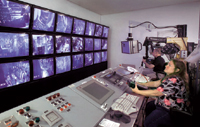 |
Project organizers developed an innovative plan to involve five DOE national laboratories in the design and construction of the project. The original partnership of Lawrence Berkeley National Laboratory, Los Alamos National Laboratory, Brookhaven National Laboratory, Argonne National Laboratory, and Oak Ridge National Laboratory represented one of the largest of its kind in US scientific history. Each laboratory would design and build a key SNS component. Oak Ridge, the home base, would put them all together and make it work.
Work began at the end of 1999. During the planning process, advances in superconducting technology led to the addition of a superconducting section to the SNS's linear accelerator, which would operate at a temperature two degrees above absolute zero and greatly improve the machine's efficiency. Thomas Jefferson National Accelerator Facility, which helped pioneer superconducting accelerator technology, would deliver the cold section, completing the six-lab collaboration.
An SNS first is its target station, a modular unit that recirculates 20 tons of liquid mercury. Designers realized that mercury's neutron-rich atoms would be ideal receivers for the SNS's powerful, pulsed proton beam, which spalls neutrons from the nuclei of mercury atoms.
|
|
|
The SNS target station circulates 20 tons of liquid mercury, a material that contains a large number of neutrons per atom. When hit by protons, neutrons emerge from the liquid and travel to the surrounding experimental areas with their instruments. |
| Photo: ORNL |
Instruments of discovery
Scientists from around the globe will come to do experiments using the instruments stationed on the 24 SNS beamlines. Some 2000 users annually will be selected by Oak Ridge through a peer-reviewed proposal system.
The SNS will have two highly specialized instruments known as reflectometers. The Magnetic Reflectometer is designed for studies of thin films; the Liquids Reflectometer will, not surprisingly, study liquids. The SNS beam intensity will allow the added dimension of "off-specular" measurements–that is, measurements of molecular structures parallel as well as perpendicular to the surface.
The Extended Q-SANS (Small Angle Neutron Scattering) Diffractometer can cover a range of spatial scales from several hundred angstroms to a fraction of an angstrom in one measurement. The Extended Q-SANS instrument, with its ability to analyze multiple scales at once, will be especially suitable for studying complex materials, particularly biological samples such as cell components.
Researchers will use the Powder Diffractometer, the most flexible and versatile of its kind, for studying small samples and performing parametric–or effect-over-time–experiments. The Backscattering Spectrometer will probe atomic-scale dynamics at high resolution, providing data up to 100 times faster than existing instruments. Probing the dynamics of atomic or molecular motion is important for materials with large surface areas.
Researchers will use the Ultra-High Pressure Diffractometer to study atomic structures at ultra-high pressures equal to those found deep in the earth or in brown-dwarf stars. A Disordered Materials Diffractometer will be used for smallangle studies of atomic structures of glasses and liquids, while the Single-Crystal Diffractometer will be optimized for rapid data collection from very small crystals, crucial for characterizing the large number of materials for which it is impossible to grow large crystals.
The SNS will have a class of spectrometers called "choppers," so named because a mechanical device interrupts the neutron beam and allows only neutrons of a certain energy to reach the sample. The speed of the neutrons as they bounce back from the sample gives researchers the data they need to analyze the characteristics of the materials.
These chopper spectrometers offer researchers enhanced sensitivity, broader ranges, and improved intensity, in some cases by factors of approximately 100. They include the HighResolution Fermi Chopper Spectrometer, optimized for single-crystal studies; the Wide-Angle Fermi Chopper Spectrometer, a lower-resolution instrument for wide-angle studies; and the 10-100 Microvolt Multi-Chopper Spectrometer, a flexible general-purpose analytical tool capable of sending up to 100 times more neutrons to the sample.
Finally, the SNS will have a beamline dedicated to the study of the neutron itself, addressing questions about the big-bang theory and physics beyond the Standard Model of particles and their interactions.
Wigner was right
At 3:30 p.m., the control room at Oak Ridge breaks out in a roar. There is lots of back-slapping, handshaking and cheering. The SNS, an hour and a half after producing its first neutrons–and a first round of cheers–has delivered its 1013 protons to the target–the beam power mark that signals official completion.
Staffers gather in the lobby of the SNS Central Laboratory. Project Director Thom Mason and ORNL Director Jeff Wadsworth stand on a stairwell holding plastic flutes of champagne to lead the gathering in a toast to success. The PhysicsDiagnostics Station electronic logbook entry reads: "Here is what so many have labored toward for so many years."
Clifford Shull, who, in the 1940s, along with Ernest Wollan saw the potential of neutrons for exploring the structure of materials, lived to share the 1994 Nobel Prize for his work in neutron scattering. Shull also saw the beginnings of the new neutron research facility on a ridge top in Oak Ridge overlooking the old reactor where he had worked just after the war. As the prescient Eugene Wigner foresaw, the SNS represents a long-awaited "something new" for the neutron science community.
"We've come a long way," says Jack Carpenter, the control-room guest who proposed the SNS idea more than 35 years ago. "I would have never envisioned how far."
Instrument |
|
|
|
The Spallation Neutron Source will deliver high-intensity neutron beams to a variety of instruments that feature special detectors to examine the interaction of neutrons with biological samples or other materials. |
| Source: ORNL |
Click here to download the pdf version of this article.



